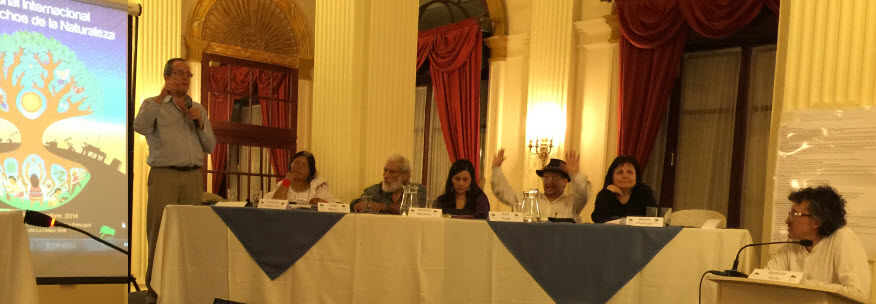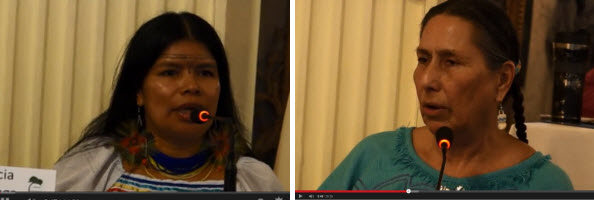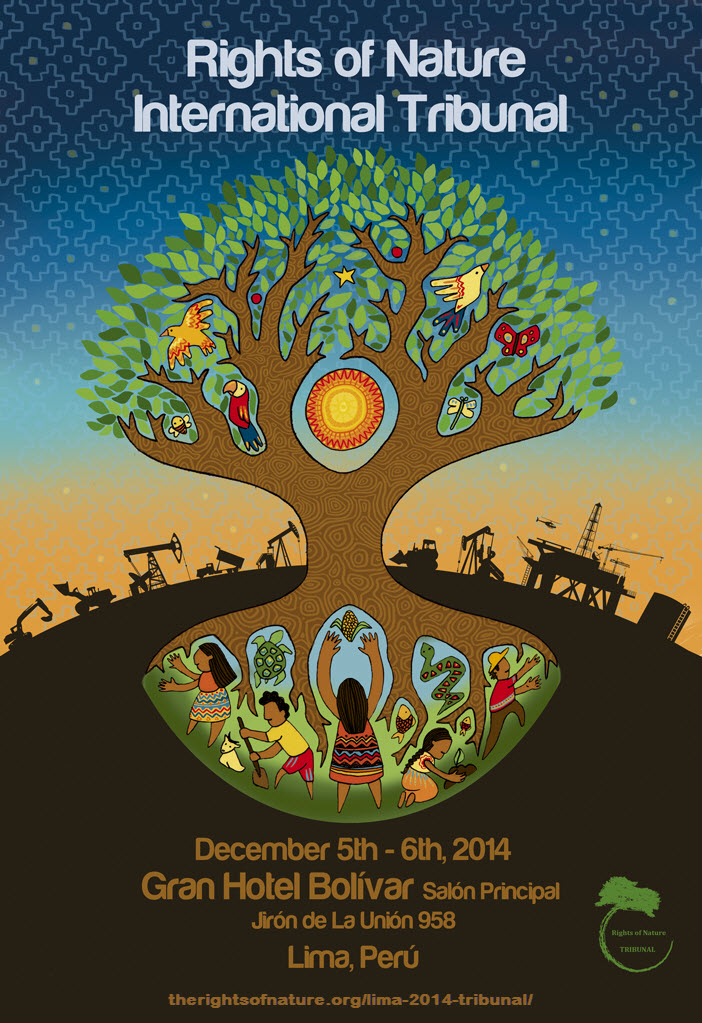International Rights of Nature Tribunal
Lima, Peru – December 2014
The second International Rights of Nature Tribunal convened December 5-6, 2014 in Lima, Peru. For two full days a panel of 13 distinguished judges heard twelve prominent cases while on the other side of the city the United Nations Convention on Climate Change (UN FCCC COP 20) deliberated. The Tribunal heard evidence from experts and witnesses who are impacted by gross violations to the Rights of Mother Earth and Nature, human rights and rights of indigenous communities.

The Tribunal proceedings were intense and deeply moving as witness after witness gave intimate testimony reinforced by scientific evidence of experts. Selected cases addressed the impacts of Climate Change, destructive oil and mineral extraction, and aggressive actions against Defenders of the Earth especially in South America. The ruthlessness of actions being taken around the world against Defenders of the Earth was brought home to this Tribunal by the death of José Isidro Tendetza Antun, Shuar leader from the Condor Mine region of Ecuador, only days before the Tribunal commenced. The Tribunal was dedicated to José Tendetza’s honor.
Casey Camp-Horinek, Ponca Nation, USA and Patricia Gualinga, Sarayaku, Ecuador opened the session sharing about Indigenous cosmovision to lay the foundation for understanding Mother Earth and living in harmony with nature.

Información sobre el Tribunal en español
A summary of the objectives and outcomes of Tribunal was presented in a Press Conference at the UN FCCC on December 8. To view a view of the Press Conference visit UNFCCC Rights of Nature Press Conference.
A distinguished panel of judges heard the cases in Lima presented by the Prosecutor for the Earth and expert witnesses:
- Alberto Acosta, economist and former President of the Constituent Assembly from Quito, Ecuador
- Raúl Prada Alcoreza, Philosopher, sociologist, author, former member of the Bolivian Constituent Assembly of 2006-2007, Bolivia
- Hugo Blanco, Political leader, leader of the Confederación Campesina del Perú, Peru
- Tantoo Cardinal, actress (e.g., Dances with Wolves) from the Tar Sands of Canada
- Blanca Chancoso, Kichwa leader and educator from Cotacachi, Imbabura, Ecuador
- Tom Goldtooth, Director of Indigenous Environmental Network, Turtle Island, USA
- Francios Houtart, professor, philosopher, theologian, Belgium
- Osprey Orielle Lake, Co-Founder and Executive Director, Women’s Earth and Climate Network, USA
- Edgardo Lander, sociologist, professor, Venezuela
- Veronika Mendoza, Peruvian Congresswoman, representing the region of Cusco, Perú
- Rocío Silva Santiesteban, National Human Rights Coordinator, author, professor, Perú
- Atossa Soltani, founder and Executive Director of Amazon Watch, USA
- Terisa Turner, professor Sociology and Anthropology, former UN Energy Specialist, Canada
Visit Tribunal Judgements for an executive summary of the Tribunal’s rulings. Review and analysis of the cases is continuing. Updates of judgements will be provided as they become available. In the Cases segment below, each case includes links to Expert Witness presentations and Rulings by the Judges. Videos and presentation documents will be added continually until complete.
Cases for the International Rights of Nature Tribunal in Lima ~ Click for Executive Summary of Tribunal Verdicts
| CASE TITLE | TOPIC | COUNTRY | CASE VERDICT | ||
| Mining | Perú | Click for Case Verdict | ||
| In Peru four Andean lakes in the mountains of Cajamarca are threatened by Conga Mine (Newmont Mining Project, Peru Buenaventura and the International Finance Corporation) which is looking to start a $4,800 million mining project. The Guardians of the lakes have promoted large demonstrations against the destruction of their lakes. The government has responded with the criminalization of hundreds of people, beatings and arrests. Five people have died and yet no one is held responsible. The government opposes the request.Objective of the Tribunal bring the case before the Tribunal. | |||||
| Mining | Ecuador | Click for Case Verdict | ||
| On March 5, 2012, the Ecuadorian government signed the first contract for metal mining on a large scale with the Chinese company Corriente ResourcesSA. The agreement allows for the extraction of copper in the Cordillera del Condor, one of the most biodiverse places in the country. This project, called Mirador, affects both the natural ecosystems and indigenous peoples of the area. Despite being presented with a legal demand organized by civil society which defined violations of the rights of nature and warned of the extinction of species and impact on water sources, the Corriente company won the lawsuit leaving nature and people helpless.Objective of the Tribunal: to present evidence and additional information on the case. | |||||
| Oil | Gulf of Mexico Mexico / USA | Click for Case Verdict | ||
| On April 20, 2010an explosion occurred on the”Deepwater Horizon”, operated by British Petroleum with the Swiss company Transocean. The explosion caused a spill of 5million barrels of oil into the Gulf of Mexico and killed 11workers.Oil continued to flow into the ocean, spilling between 12 and 19thousand barrels of oil daily. The spill stopped in July of that year, but the damage to the marine ecosystem persist and will persist for much longer.Objective of the Tribunal to hear more evidence and solve the case with a sentence. | |||||
| Infrastructure / Hydroelectric | Brazil | Click for Case Verdict | ||
| The Belo Monte hydroelectric plant is being built by the Norte Energia Consortium company in the Xingu river in the state of Pará, Brazil. The plant has a planned capacity of 11,000 MW, making it the second largest Brazilian hydroelectric dam, and the world’s third largest. This dam will devastate an area over 516 km2 of the Brazilian Amazon and cause the displacement of 20,000 people, affecting the livelihoods of dozens of indigenous families and communities. The Xingu basin is highly biodiverse and is home to 25,000 indigenous people from 24 ethnic groups such as the Kayapó, Arara, Juruna, Araweté, Xikrin, Asurini and Parakanã.Objective of the Tribunal: present the case to the Tribunal. | |||||
| Oil | Perú | Click for Case Verdict | ||
| In northern Peru four river basins which are tributaries to the Amazon river, have been polluted by more than 43 of years of oil contamination, destroying ecosystems, human being, and life itself in the deepest regions of the Amazon. Between 2013 and 2014 the four rivers, Maranon, Tiger, Pastaza and Corrientes, were declared in state of environmental emergency. Peruvian government implemented a Multisectoriel commission to find immediate solutions for the environmental , cultural and social damages of more than 43 years of uncontrolled oil exploitation. But so far no solution has been brought to these rivers. Instead or on top of that, Peru is weakening environmental standards and control , and keeps on persecuting land defenders. The indigenous federation of Quechua of Pastaza (FEDIQUEP) will talk about 40 years of suffering of the living beings of Pastaza through the emblematic case of the loss of the Shanshococha lake. The organization of ACODECOSPAT (Kukama Kukamiria) will present the case of the contaminated National Reserve Pacaya Samiria where this year no less than three big oil spills occurred. Objective of the Tribunal: present the case before the Tribunal. | |||||
| Oil | Ecuador | Click for Case Verdict | ||
| On February 5, 1964 the government of Ecuador signed the concession with the Texaco Consortium of Gulf Oil for oil exploration in the northern region of the Ecuadorian Amazon. In operation until 1992, the company operations had devastating impacts on the environment, and therefore on the area’s population. The operation deforested more than 2 million hectares, spilled more than 650,000 barrels of oil, and dumped millions of gallons of formation water and heavy metals into their area’s water sources, affecting indigenous and mestizo populations of the region. The affected communities have won major victories in the courts against Chevron/Texaco over the past 20 years of the case. However the devastating damage left by the company, both to the natural rainforest and its inhabitants remain.Objective of the Tribunal: hear more evidence and solve the case with a sentence. | |||||
| Defenders of the Earth | Perú | Click for Case Verdict | ||
| The Law of the Jungle in Peru, refers to the application of ten legislative decrees and laws under the Free Trade Agreement between Peru and the United States dealing with the lives of indigenous peoples. In May 2008 Amazonian indigenous peoples began protests against this package of decrees, directed in favor of the transnational oil and mining corporations. These protests were confronted by government force. Violence ensued which left 34 people dead, and over 200 wounded. Five years later, 52 indigenous leaders have lawsuits against them.Objective of the Tribunal: present the case to the Tribunal | |||||
| Oil | Global USA /Bolivia /Argentina | Click for Case Verdict | ||
| Hydraulic fracturing is a well-stimulation technique to release oil and gas through high-pressure injection of water, sand and chemicals into rock formations rich in hydrocarbons. This technique affects various parts of our planet and jeopardizes the rights of nature. Hydraulic fracking is a wide-spread reality in the United States and an emerging possibility in Bolivia and Argentina. The case was filed in the initial Tribunal in Quito and accepted as a possible violation of the rights of nature and the rights of people who, despite being against the technique, have to live with the devastating effects.Objective of the Court: to present evidence and further information about hydraulic fracturing as a problem in several parts of the world. | |||||
| Climate Change | Global | Click for Case Verdict | ||
| The effects of climate change on our planet include: increases in sea level, ocean acidification, biodiversity loss, impacts on water cycles, desertification, fires, and weather event increases, among others. Half of the animals on the planet are at risk of disappearing. The Quito Tribunal accepted the case of Climate Change and advancing of false solutions as a clear violation of the rights of nature, water, animals, and people. The case raises the need to move to a system in harmony with nature to replace the capitalist model of infinite growth and accumulation. The Tribunal in Lima will hear additional evidence regarding the impacts to Mother Earth, realities of false solutions and those responsible for these crimes against nature.Objective of the Tribunal: present evidence and advance the case towards COP21 in Paris-France. | |||||
| Forests | Global / USA/ Kenya/ Costa Rica / Brazil | Click for Case Verdict | ||
| REDD (Reducing emissions from deforestation and forest degradation) is a global initiative to create a financial value for the carbon stored in native forests and tree plantations, soils and agriculture, including plankton and algae in the oceans. This involves the opening of the carbon cycling capacity of the Earth to economic valuation and trading in financial market systems. Indigenous peoples, forest dwellers, small farmers and peasants view REDD as a false solution for mitigating climate change that have resulted in land grabs, evictions and human rights abuses. REDD is inherently about commodifying and privatizing air, trees and land by selling nature and air to generate permits to pollute. These permits to pollute also known as carbon or emission credits are used by polluters to avoid reducing greenhouse gas emissions at source. This Tribunal on REDD and forests will listen to testimonies on the concern of REDD and other carbon and emissions trading and offset regimes violating the rights established in the Universal Declaration of the Rights of Mother Earth.Objective of the Tribunal: present the case to the Tribunal. | |||||
| Fossil Fuels | Australia | Click for Case Verdict | ||
| The Great Barrier Reef is the world’s largest coral system. It is the largest structure made by living organisms that can be seen from space. It stretches over 2,300 kilometers and has more than 3,000 individual coral systems. The reef provides life support to hundreds of species of fishes, sharks, rays, whales, dolphins and mollusks. It is designated a World Heritage site by UNESCO, an institution that in June 2011 issued a warning to the Australian government about the threat to the Great Barrier Reef due to the expansion of ports, especially for the export of coal, dredging, agricultural sediments and industrial developments near the reef.Objective of the Tribunal hear more evidence and solve the case with a sentence. | |||||
| Oil | Ecuador | Click for Case Verdict | ||
| Yasuni National Park is the most biodiverse place in the Eastern Hemisphere. There are 982,000 hectares of Amazon forest Pleistocene refugium with the highest biodiversity on our planet. This diversity exceeds the total number of trees in the United States and Canada. It is also home to two indigenous peoples in isolation, the Tagaeri and Taromenane. Ecuador tried to stop drilling in the ITT oil block through the Yasuni-ITT Initiative. However on August 15, 2013 the government decided to exploit oil in spite of the great ecological risk given the fragility of the area. The same year civil society formed the Yasunidos Collective and collected more than 750,000 signatures to call for a national consultation on the move but no action has been taken by the government to recognize the order. In January2014 the International Rights of Nature Tribunal accepted the case of the exploitation of Yasunias a potential violation of the rights of nature. Since the acceptance hearing, two special sessions heard evidence and witnessed what might happen in Yasuni, the people who live there, and transgressions to those who defend the parks such as Yasunidos. In the April 11 session, the Tribunal formed a special Commission for the surveillance of Yasuní. During the August 15, 2015 hearing, the Tribunal condemned the violations of the rights of nature in the Yasuni and violations against its defenders.Objective of the Tribunal: review judgments of Special Sessions and issue a final ruling. | |||||

International Rights of Nature Tribunal Background (Video story)
In January 2014, the Alliance launched the International Rights of Nature Tribunal in Quito, Ecuador in conjunction with the 2014 Global Rights of Nature Summit. The Tribunal is to be a permanent international people’s tribunal for Rights of Nature.
For the initial launch in January 2014, nine diverse cases were presented to a distinguished international, multicultural panel of judges. The Universal Declaration of the Rights of Mother Earth, and in selected cases the Ecuadorian Constitution, provided the legal basis for review and judgment. Among the cases were the Chevron-Texaco pollution case (Ecuador); BP Deep Horizon oil spill (USA); Yasuní-ITT oil project (Ecuador); the endangerment of the Great Barrier Reef by coal mines (Australia); hydraulic fracturing (USA) and the impacts of Climate Change (global). Videos and presentations from the Rights of Nature Tribunal are posted at wordpress-566259-1826367.cloudwaysapps.com/rights-of-nature-tribunal/. Since the launch, a Chamber convening of the Yasuni-ITT case has presented a verdict in August 2014. See Yasuni Verdict.
Objectives of the Tribunal
The Rights of Nature People’s Tribunal provides a vehicle for reframing prominent environmental and social justice cases and adjudicating the cases within the context of a Rights of Nature based earth jurisprudence. While the Tribunal does not have specific legal authority, the adjudication process provides a catalyst for informed legal analysis of diverse cases, recommended mitigation based on Rights of Nature, and expanded international authority as the process matures.
With each case the Tribunal will recommend actions for reparation, mitigation, restoration and prevention of further damages and harm. The Tribunal will encourage parties to engage in mediation and restorative justice or other dialogue processes it may deem appropriate.
The Tribunal provides a framework for educating civil society and governments on the fundamental tenets of Rights of Nature and an instrument for legal experts to examine constructs needed to more fully integrate Rights of Nature.
The Tribunal process demonstrates Rights of Nature / Rights of Mother Earth as a framework for addressing Climate Change Solutions, creating a truly green economy and ending Ecocide on our planet.
Intended Results –
- Rulings of the Tribunal with respect to cases involving alleged violations of the Rights of Nature laws and/or the Universal Declaration of the Rights of Mother Earth;
- Furthered development of earth jurisprudence by writing and disseminating judgments that interpret Rights of Nature laws and the Universal Declaration and apply the related rights and obligations to the specific facts of the cases heard;
- Definition of proposed solutions for mitigating issues and harmful impacts related to specifics cases heard, preventing further harm and restoring the systemic health of the impacted communities.
- Broaden international acceptance of the concept of the Rights of Nature and of all beings and the universal observance of the rights and duties contained in the Declaration; and
- Demonstration of how the application of the rights and duties contained in Rights of Nature laws and the Universal Declaration of the Rights of Mother Earth promotes the harmonious co-existence of humans and other beings in a manner that enhances the integrity, health and functioning of the Earth community.
The event was livestreamed at http://www.livestream.com/ecologiapolitica.
Other articles:
Fracking and Lima climate talks slammed at Nature Rights Tribunal by David Hill, The Guardian
http://www.theguardian.com/environment/andes-to-the-amazon/2014/dec/10/fracking-redd-lima-climate-talks-slammed-nature-tribunal
